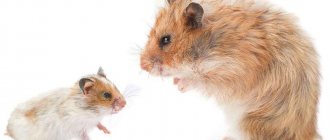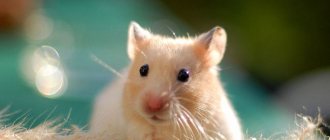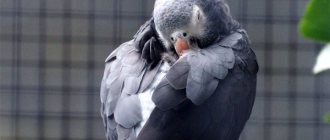Common hamsters, which are most often kept at home, are distinguished by the special structure of their dental system. They have incisors on each jaw, and their growth does not stop throughout their lives. Hamsters constantly wear them down on hard food or pieces of wood, which is the reason for their habit of gnawing on everything that is available around them.
Dental disease is a serious problem for these animals. Hamsters cannot eat normally, and this has negative consequences for the entire body, so it is important to help them in time.
What color are a hamster's teeth?
Hamsters have a natural enamel color that is yellow, not white as you might think. It is not uncommon to encounter rodents with very yellow or even brown teeth. This indicates that the hamster is either too old or has a lot of dyes in its food.
ATTENTION! In a healthy rodent, the color of the teeth is yellowish or even orange - this is a natural shade that is present in healthy individuals.
There are also hamsters with white teeth - this is not an indicator of the health of the rodent. Typically, white teeth are seen in old or sick hamsters. Therefore, if your pet has snow-white enamel, this is a sure sign to consult a veterinarian.
Lymphocytic choriomeningitis
A serious infectious disease, it is incurable, so if a pet becomes infected, it will have to be euthanized and an autopsy performed to determine the cause of the disease. The first symptoms are weakness, difficulty breathing, fever. The main carriers of the causative agents of lymphocytic choriomeningitis are mice, therefore, to prevent the disease, it is necessary to protect your pets' country enclosures from these rodents. It is also very important to observe the rules of personal hygiene, since this disease is also dangerous for humans.
Why do hamsters sharpen their teeth?
The main reason for this procedure is that the dental tissue in hamsters does not have roots, so the teeth of this type of rodent are constantly growing. The nerve endings are located at the very bottom, so the point of the teeth does not bring pain or discomfort to the hamster.
Sharpening teeth is extremely necessary for rodents, so you need to take care of this in advance. Currently, pet stores have a large selection of special items for sharpening dental tissue.
Heart diseases
It is quite rare in hamsters. The reason for their appearance may be severe stress or high ambient temperature. Symptoms of the disease include weakness, rapid breathing and pulse. If such signs appear, then you must take your pet to a veterinarian, who will prescribe adequate treatment. During the period of therapy, you should place the cage with the hamster in a quiet, dark place with an air temperature of 22-25°C. If the animal becomes very ill, it is necessary to inject it with Effortil and place a small piece of ice on the back of its head.
How do hamsters sharpen their teeth?
If the owner has not provided special items for sharpening teeth, then the hamsters begin to chew the bars of the cage. This can not only cause a damaged cage, but also negatively affects the condition of the pet’s oral cavity.
To avoid this problem, you can place a special mineral or chalk stone in the cage, or you can use fruit tree branches. These items are sold at any pet store and are completely inexpensive. Thanks to this, the hamster will not only grind down its teeth, but also receive useful minerals necessary for the normal functioning of the body . Take care of your pet, as well as the health of its teeth and body as a whole.
Does your pet have mineral stone for their teeth?
Possible reasons
Hamsters show interest in any hard objects, as they belong to the class of rodents. Their teeth grow very quickly and need to be ground down regularly. House rods are the most suitable option. Another reason why hamsters chew their cage is boredom. Animals are very fond of all kinds of wheels and labyrinths. If you don’t have them yet, pamper your pet with toys - this way he will be much less likely to touch his cage with his teeth. Lack of activity contributes to the development of a bad habit, so give the animal the opportunity to be active.
Hamsters chew their cage out of boredom and because they have fast-growing teeth that need to be ground down regularly.
Unwanted noise may occur due to hunger. Check the feeder regularly for food and provide your rodent with more solid food. Another option is that the hamster does not like his home; he feels cramped in it. Gnawing through the cage, he is about to leave the space and signals you about this. In such a situation, you should not save money - move your pet to a more spacious house. If this is not possible, you need to let the animal out for a walk every day. Pre-prepare a place for this and fence it off.
If the listed cases do not apply to you, perhaps the hamster has health problems or something is bothering him.
Carefully examine the rodent - there may be wounds and tumors on the body. Animals often climb on bars; they can pull their paw and it will hurt. If the pet is still very small and chews on the cage, most likely he wants to go for a walk.
What to do if your hamster loses a tooth?
There are also times when hamsters’ teeth fall out. This is influenced by many factors.
Teeth loss in a hamster occurs for several reasons:
- unbalanced diet;
- Animal feed contains large amounts of refined sugar;
- the food contains too large and hard pieces of food;
- the animal is injured due to a fall from a long distance;
- due to a fight between two animals;
- due to the fact that the hamster chewed too hard on the bars of the cage;
- lack of nutrients and vitamins.
There is no need to worry too much if your pet's tooth falls out, as it will soon grow back. As mentioned earlier, the dental tissue in hamsters is constantly growing; even at the time of old age, hamsters’ teeth continue to grow . Therefore, you should not worry too much, but it is extremely necessary to eliminate the reasons why the disorder occurred in the animal’s body.
If the cause of tooth loss is a lack of calcium, then it is necessary to introduce foods such as cheese and milk into the hamster’s diet. They contain a large amount of calcium, which will help your pet in the fight against tooth loss. This is an important vitamin that needs to be included in your pet's diet.
Trichomoniasis
The causative agent of the disease is the parasite Trichomonas gallinae. It enters the pet's body along with dirty water or food of poor quality. Young rodents are most susceptible to the disease. The first symptom of the disease is a yellow tint covering the inside of the throat. Over time, this organ begins to increase in size, making eating and breathing difficult. If timely treatment is not carried out, the pet begins to eat little, lose weight, and then suffocate.
To prevent trichomoniasis, it is necessary to treat and disinfect the cage, cages, equipment, houses, enclosures and accessories. Your hamster's dishes should also be kept clean at all times.
When does a hamster need to have its teeth trimmed?
Old individuals who are no longer able to chew hard objects need to have their incisors trimmed. A hamster's teeth continue to grow even into old age, so it is necessary to trim your pet's teeth yourself.
If you see that the length of the dental tissue significantly exceeds the normal length, then you can take the animal to a veterinary clinic, but if you do not have the opportunity, then the procedure can be performed independently at home. This is done using nail clippers.
IMPORTANT! You need to act as carefully as possible so as not to harm the animal or cause damage.
Possible problems
Ornamental animals at home are often deprived of the instincts and way of life that are inherent in their relatives in the wild. That is why this often leads to many problems, including those with the oral cavity. That is why, regardless of age and conditions of detention, attention should be paid to the pet every day.
What to do if your teeth don't sharpen
A huge number of hamster owners face this problem. It often occurs as a result of an unbalanced diet or if the animal’s natural instincts at home are somewhat dulled. Often this phenomenon is accompanied by general lethargy of the rodent or other symptoms indicating systemic ailments. Therefore, it is recommended that your hamster be thoroughly examined by a veterinarian.
Did you know? Roborovsky's hamster is recognized as the smallest hamster in the world. This rodent lives in Mongolia, its average length reaches 4–5 cm, and its weight does not exceed 30 g.
If the rodent is completely healthy and simply does not have time to wear down its teeth, they definitely need to be trimmed. To do this, you need to take nail scissors or nail clippers for cats. This must be done carefully, with smooth movements, up to a length of 5 mm. At the same time, it is also recommended to trim the claws on the paws so that the hamster does not injure himself and others. However, it is recommended to do all this at home only if you have the appropriate skills. In other cases, it is strongly recommended to consult a veterinarian.
Broken upper or lower tooth
Also, often during active games, an animal can break its front incisor. In this case, the lower or upper tooth can break on its own, due to an unbalanced diet or in adulthood. If you do not take decisive action, this can lead to serious problems in just 1-2 weeks.
Pay attention to the description of the Angora hamster.
First of all, the sharp edge can injure the oral cavity, which will cause many difficulties for proper nutrition. It should also be taken into account that the incisors do not grow synchronously, so over time the difference between the length of a healthy and broken incisor will be significant. To prevent all this from happening, the broken incisor must first be polished with a nail file. After this, the adjacent long tooth must be shortened to the length of the broken one.
Uneven growth of incisors
This problem can arise due to a number of factors, which also include genetic predisposition and the impact of closed living conditions. That is why it is not easy to accurately answer the question of why this happens. This pathology can take on a varied type of course, with each incisor growing either asynchronously or in pairs. In the latter case, there is a pathological enlargement of the two lower or two upper teeth, which can reach truly gigantic sizes.
To help the animal, the incisors need to be shortened to a single length. After this, you should definitely review the hamster’s diet by adding an additional portion of dry food, as well as fresh branches of fruit species.
What to do if your teeth are chattering
Sometimes a characteristic knocking sound may indicate problems with teeth. This occurs due to an incorrect taste caused by excessively long incisors. As a result, the pathological process leads to unpleasant or painful sensations that contribute to severe discomfort. This is especially evident with uneven growth of the incisors and subsequent distortion of taste.
Did you know? Hamsters are considered one of the most ancient rodents. They appeared on the planet long before humans, back in the Miocene era (8–12 million years ago).
However, a hamster can chatter its teeth even with a whole range of ailments, including cancer. That is why, when such a problem occurs, you need to contact a veterinarian as soon as possible. Often this will help prevent the development of serious consequences and death of the pet.
What to do if your hamster has very long teeth?
If your hamster's teeth grow to an unacceptable length, this will negatively affect the animal's life. The rodent will not be able to eat normally, and it also increases the risk that the animal may be injured. If you do not pay attention to this problem in time, the hamster may even die, so take this issue as seriously as possible.
If the length of a rodent's teeth exceeds the norm, then the help of a veterinarian is necessary. But it is not always possible to use the services of a specialist. Therefore, in some cases you will have to resort to cutting your teeth yourself.
Breaking the habit
If your hamster regularly chews on its cage, it may become injured over time. But this is not the only possible reason why he needs to be weaned from this activity - loud sounds disturb a person’s proper sleep. Another danger is that your pet may chew through the bars and escape.
Theoretically, everything seems very easy, but in reality difficulties arise, since the instinct to “gnaw” is inherent at the genetic level. Rodents have upper teeth that grow throughout their lives because they do not have roots. In the wild, hamsters feed on roots and grains, which is why they wear down their teeth well. Domestic animals do not have to look for food, but the need inherent in nature remains.
Experienced hamster keepers know well what to do if a hamster chews on its own cage. We need to redirect his energy in another direction. One way to solve the problem is to add vegetables, fruits, crackers and various solid foods to the food. You can offer the animal cardboard. The cages are great for holding rolls left over from toilet paper or paper towels. Such rolls will become interesting toys for an animal that loves to hide in minks and shelters. Grinding teeth is a necessary process, without which the incisors can injure the animal’s mouth. It is important that it happens naturally. Only as a last resort should you seek help from a veterinarian.
How to trim a hamster's teeth
To carry out this procedure you will need nail scissors. You can also use nail files or scratching posts, which are usually used for cats. It is necessary to trim the length of teeth with extreme caution, removing only the excess length of dental tissue.
The nippers must be well sharpened so that the animal does not get injured. During this procedure, be extremely careful not to cut your hamster's tongue or cheeks.
After the procedure, you should not feed the hamsters solid food, so as not to injure the dental tissue. Give preference to soft food. If you notice that your hamster is feeling well, you can gradually introduce solid pieces of food into his diet.
Important nuances
Experts recommend combining several different methods. For example, a wheel, a mineral stone and a treat. This way, he will not only stop making noise, but will also not gain extra pounds and will increase his immune strength. In addition, the problem of teeth grinding will be solved.
There is a more radical method - to move the animal into a terrarium or a spacious aquarium. The main thing is that it has good ventilation. This method will help protect the rodent from the toxic paint that is used to paint cells, provide you with sound insulation, and simplify the process of cleaning your home. In addition, it is much more fun to keep an eye on your pet through glass.
If, after all the measures taken, the hamster stops gnawing on the rods, it means that he is happy: he sleeps enough, eats treats, does not get bored and frolics with toys. But if the animal continues to make noise, the activity clearly brings him pleasure. You will have to come to terms with your pet’s character and place the cage as far away from the bed as possible at night.
How easy is it to care for dzhungarika?
Often a hamster is bought as a gift for a child. This is a wise decision, because the baby will definitely get a positive experience from communicating with his pet, he will learn to take care of someone and be responsible for a living being. A child who has reached the age of 8-9 years can safely be trusted with this matter. But you shouldn’t trust a very tiny baby with a jungarik, he can cripple him or cause aggression in the animal with his childish spontaneity.
Photo: https://pixabay.com/photos/hamster-rodent-pet-2462048/ Keeping and caring for a pet will not create much difficulty. A clean animal maintains its own appearance, it washes itself and cleans its fur with its paws.











